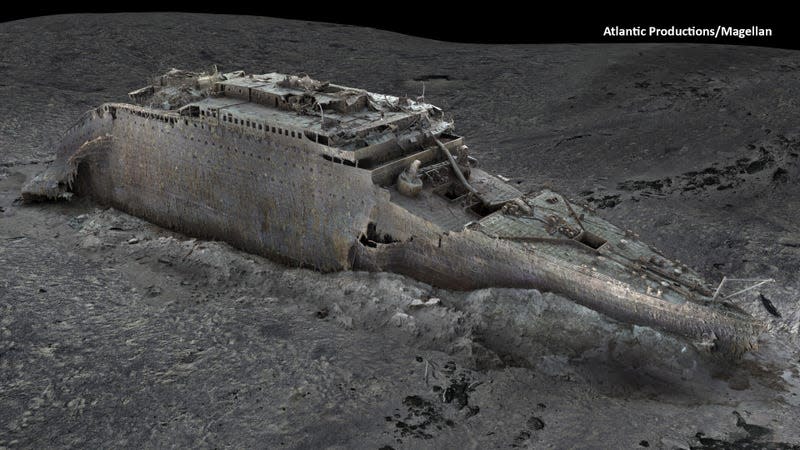New 3D Scans Show the Titanic in All Its Sunken Glory

The RMS Titanic struck an iceberg on its maiden voyage and sunk to the bottom of the Northern Atlantic Ocean in April 1912, killing more than 1,500 passengers and crew. Now, researchers have gotten an unprecedented look at the entire ship on the seafloor, by creating a digital scan of the wreck from hundreds of thousands of photos.
The BBC reports that deep-sea mapping company Magellan Limited carried out the fieldwork in the summer of 2022 alongside Atlantic Productions, a production company that is making a documentary about the process. Researchers from the two organizations spent six weeks using submersibles to take over 715,000 images of the 3-mile-wide Titanic wreck site, which is about 12,500 feet (3,800 meters) below the surface of the Atlantic Ocean. Those images were then stitched together to create a 3D, digital replica of the doomed ship.
Read more
“We used two cutting edge submersibles that are named Romeo and Juliet which were operated simultaneously to provide the third person view of the Digital Twining process and to ensure the site was undisturbed throughout the operation,” Magellan’s 3D capture specialist Gerhard Seiffert said in a press release. “What we’ve created is a highly accurate photorealistic 3D model of the wreck. Previously, footage has only allowed you to see one small area of the wreck at a time. This model will allow people to zoom out and to look at the entire thing for the first time.”
When the researchers finished scanning the ship, they were left with 16 terabytes of data and 4k video of the wreck. Months of processing and rendering has resulted in the final 3D model, videos and stills of which were released by Atlantic and Magellan today. The model captures the entirety of the ship but also shows smaller details like the boilers, unopened champagne bottles, and even a serial number on a propeller, according to the BBC. This new model could help historians and engineers learn more about the circumstances that led to the infamous sinking of the Titanic.
“We’ve got actual data that engineers can take to examine the true mechanics behind the breakup and the sinking and thereby get even closer to the true story of Titanic disaster. For the next generation of Titanic exploration, research and analysis, this is the beginning of a new chapter,” Titanic expert Parks Stephenson said in the press release.
The new digital model is yet another demonstration of how modern science is helping us study famous shipwrecks. Last year, a team announced the discovery of the well-preserved wreck of Endurance, the ship that carried Ernest Shackleton’s 1914 Antarctic expedition.
Earlier this year, researchers with the National Oceanographic and Atmospheric Administration, the state of Michigan, and Ocean Exploration Trust found a long-lost sunken ship in the depths of Lake Michigan. The Ironton sank in 1894 and wasn’t seen again until a team imaged the ship using sonar—and found it sitting strikingly upright on the lake floor.
More from Gizmodo
Sign up for Gizmodo's Newsletter. For the latest news, Facebook, Twitter and Instagram.

